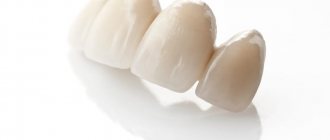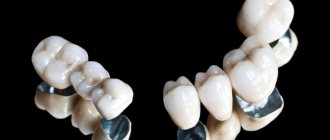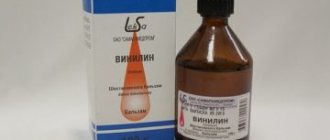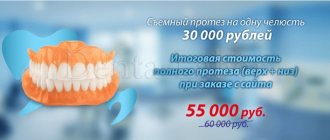Description of the main characteristics of alloys
Hardness as the property of a material to resist the penetration of an indenter—another solid body—into it. This parameter determines the occlusal wear resistance and how the dentist can process and polish the prosthesis.
The yield stress is the stress required to cause permanent plastic deformation in tension. The proof strength is the stress that occurs at a strain of 0.2%. This parameter characterizes the strength of the alloy more than others. This is what people pay attention to first when choosing the design of a prosthesis.
The elastic modulus is another important property that determines the flexibility of a metal frame. An alloy with a high modulus of elasticity bends less under load than an analogue with a low modulus.
Elongation is the ductility of a material, measured as a percentage. The lower this indicator, the more fragile the alloy will be.
The melting temperature range is an important parameter to prevent frame deformation when firing ceramics.
Biocompatibility means that the alloy material is safe for the tissues of the body and humans in general. Non-noble alloys have mixed biocompatibility and should be used with caution.
Manufacturability is the maximum precision in manufacturing and processing of the frame.
The coefficient of thermal linear expansion indicates the compatibility of the alloy with ceramics. The main condition is that the coefficients of the alloy and ceramics must match as much as possible, and there should be no residual stress left in the finished restoration.
Technological aspects of metal ceramics
In the process of manufacturing metal-ceramic structures, there are a number of key points that deserve special attention.
- Tooth preparation for metal ceramics.
- The tooth must be prepared (ground) with a ledge at the gum level.
- The total thickness of the metal frame and the ceramic mass covering it is about 1.5 mm. As a result, if the tooth is ground without a ledge, we get the edge of the crown hanging over the gum and pressing on it. The crown presses against the blood vessels and a “bruise” forms. The metal frame comes into direct contact with the gum, and metal ions cause it to darken.
- In the case of preparation with a shoulder, the edge of the metal-ceramic crown rests on the hard tissues of the tooth without injuring the mucous membrane. This technology is quite labor-intensive, and its implementation requires a modern dental unit and, of course, the qualifications of a doctor and dental technician.
- The intermediate part of the metal-ceramic bridge prosthesis should also not put pressure on the mucous membrane (gum), otherwise bedsores may form. Of course, in those places where it is visible, you have to make a compromise, but in any case the touch should be very gentle. And if food gets into a place where there is a loose seal, it will be much easier to remove it from there than in the case of the “full contact” option.
- Many doctors “sin” by depulping (removing the nerve of the tooth) even healthy teeth under metal-ceramics, which is not always justified, since modern technologies make it possible in many cases to avoid this procedure. Depulped (dead) teeth cannot resist infection and often have to be re-treated. In addition, a pulpless tooth becomes more fragile and can collapse under a heavy metal-ceramic structure.
Properties of noble alloys
The ideal option, according to most dentists, is expensive gold-platinum alloys. They have impeccable mechanical and physical properties, high biocompatibility and are well combined with ceramics. The most famous noble alloys produced in Russia are “Plagodent” and “Plagodent Plus”.
Palladium in combination with gold forms alloys with excellent physical and mechanical properties and high corrosion resistance. They have a decent yield strength and high tensile strength, so long bridges and permanent elements of locking joints are made from them. In appearance they resemble base alloys. Only 10% palladium in the composition gives the alloy a white color, similar to steel.
Working with palladium structures requires certain skills from the dentist due to the high melting point of the alloy and special casting techniques. Soldering and laser welding should be avoided. Gold-palladium alloys are cheaper than gold-platinum alloys: due to different densities, the difference in cost can reach 2-2.5 times.
The percentage of noble metal in the alloy affects corrosion resistance and biocompatibility. The cost of a prosthesis can only be reduced by switching to non-precious alloys. A noble alloy may contain a high or low gold content, or may not contain this element at all, as, for example, in silver-palladium compositions.
Alloys in cermets
To make a metal-ceramic crown, the dental technician first makes a metal frame that exactly matches the contours of the tooth prepared for prosthetics. The frame is the most important part of the design of a metal-ceramic crown.
There is a saying: “the mouth is the beginning of the stomach, saliva is the first “stomach” juice.” Saliva is rich in a variety of enzymes. As a result of a chemical reaction, the metals that make up the alloy of the metal-ceramic prosthesis are “washed out” by saliva into the oral cavity in microdoses. Next, saliva with microdoses of metals is swallowed, absorbed through the gastrointestinal tract and enters the liver. This causes slow poisoning of the body.
The ceramic layer covering the outside surface of the metal frame is a good barrier to saliva and is an excellent insulating material. The teeth are isolated from the metal with high-strength cement, which completely protects your tooth from harmful factors, but metal is still present in the structure, and no one can guarantee that subtle biochemical reactions between your body and the metal frame do not occur.
There is no “best alloy” that suits everyone; patients have different sensitivities to certain elements. The determining factor here is the degree of corrosion. The fewer components of the alloy are dissolved, the less danger there is of a pathological reaction of the body to metal-ceramics. It follows from this that the alloy should contain a minimum of base components, because they are more susceptible to corrosion compared to noble metals.
Determination of the allergic effects of the alloy is carried out using tests on animals. Direct transfer of results to humans is not shown, however, it is possible to establish the allergic potential of the alloy.
What determines the color of noble alloys?
Doctors pay attention to color. It is believed that a very yellow alloy containing a lot of gold improves the color of ceramics: the oxides of such alloys are easily coated with a thin layer of opaque and look aesthetically pleasing. A patient who observes the golden color of the crown frame at intermediate stages has no doubt about the need to purchase such an expensive prosthesis.
In some noble alloys, the proportion of palladium, platinum or silver is increased, so they lose their yellow color, but remain just as strong. Such varieties are suitable for the manufacture of extended bridges, with or without implant support. If you are going to install a single crown, you can get by with an option with a high gold content and a low content of platinum group metals.
Alloys with fewer noble components have a pronounced yellow color and do not have such good properties as white alloys. They contain a high content of indium, which in combination with palladium gives a bright straw color. They do not have sufficient elasticity and corrosion resistance. They are used mainly in China and India on a massive scale to reduce the cost of dentures.
Aesthetic properties of metal ceramics
Metal-ceramic crowns have excellent aesthetic qualities. Modern technologies make it possible to achieve any shade of ceramic coating color.
In the 60s and 70s, there was a fashion for the so-called “Hollywood smile”, to create which metal-ceramic dentures with straight white teeth were made. Despite its external attractiveness, the “Hollywood smile” is unnatural, lifeless and, with rare exceptions, does not match the remaining teeth.
Increasingly, patients began to express wishes that artificial teeth would not differ from the preserved natural ones. But the possibilities of materials for the manufacture of metal-ceramic dentures were then very limited.
This led to the emergence of a number of research projects aimed at developing dyes, effect masses, opalescent porcelains, etc. A revolutionary step in the development of materials for creating natural aesthetics in dentures was the creation of the internal coloring technique, developed by one of the world's most famous dental technicians, Hitoshi Aoshima. The principle of this technique is that all the characteristic features of the tooth are not drawn with dyes on the surface of the metal-ceramic prosthesis, but are modeled from the inside.
Luster (glossy) porcelain was also developed. Research scientists have come to the conclusion that tooth enamel, in its shine, resembles the surface of a pearl. To imitate the natural shine of enamel, scientists have created a new technology for producing opalescent materials. The surface of luster porcelain, thanks to the ultra-fine structure of the particles, resembles the enamel of a natural tooth in its relief, ability to transmit light and color.
If the metal ceramics nevertheless turn black, then the reason for this may be trivial - the patient forgets to brush his teeth. If the lowest layer of ceramic, opaque, does not sufficiently dampen the metal frame and allow chromium ions to pass through (in the case of a cobalt-chromium alloy), then they give the accumulated plaque an unpleasant greenish tint. Individual oral hygiene is very important for everyone, and especially for those who have metal-ceramic dentures.
Three types of base alloys
Chromium alloys have been used in dentistry for more than eighty years. They are characterized by good corrosion resistance, strength, high modulus of elasticity, low density and affordable price.
- Nickel-chrome-containing alloys are used more often for frames for the purpose of further cladding. They contain 62-82% nickel and 11-22% chromium, as well as additives - molybdenum, silicon, manganese, iron, gallium, titanium, zirconium.
- Cobalt-chrome alloys contain 50-65% cobalt, 25-35% chromium and 2-6% molybdenum with rare exceptions.
The melting point of these alloys is between 1140 and 1460 °C. The polished surfaces of the dentures are shiny, silvery-white. Light weight, density slightly exceeds 8 g/cm3. Such alloys are excellent for installing single-type crowns and bridges on teeth; they are stronger and harder than noble alloys, but require the use of special abrasive tools during machining. Occlusal correction, polishing and removal of dentures cause certain difficulties and require much more time.
The bond between ceramics and metal is as strong as that of noble alloys. Casting is less precise, which is not noticeable on small castings. The issue of biocompatibility is questionable. Nickel and chromium are strong allergens.
- Titanium alloys have low density, excellent mechanical properties, high biocompatibility and corrosion resistance. However, casting titanium alloys for the manufacture of fixed prostheses has become obsolete due to the high cost and technological complexity of the process. Milling is much more often used.
In order to save money, stainless steel is increasingly being used for the manufacture of fixed dentures. Stamped crowns are characterized by their low cost and minimal amount of tooth preparation. In foreign dentistry they are used for temporary prosthetics of baby teeth.
Base metals in dentistry
In addition to steel, cobalt-chromium alloy can be used in dental treatment. Its composition looks like this:
- From 3 to 5% nickel. This element is added to simplify the processing of the material, increase viscosity and ductility.
- From 4 to 5.5% molybdenum. This additive improves strength characteristics.
- 0.5% iron.
- 0.5% silicon.
- 0.2% carbon.
- 66-67% cobalt. The alloy base is a light metal with good strength characteristics.
- From 26 to 30% chromium. This element increases the material's resistance to corrosion.
The alloy is used primarily for casting. It can be used to make bridges and clasp prostheses, clasps and crowns. In addition, it is used as a frame material in metal ceramics.
Titanium-based alloys should also be mentioned. This metal is difficult to process, but it has a unique ratio of lightness and strength. Used alone or in combination with nickel.
Primary requirements
The important properties that metals and alloys in dentistry must have are:
- high biological compatibility;
- resistance to corrosion and tarnishing;
- maintaining constant volume and shape;
- safety, no toxicity;
- inertness in the oral cavity;
- mechanical properties (strength, hardness, rigidity, wear resistance, ductility);
- physical properties (density, malleability, thermal conductivity, melting point);
- aesthetic indicators;
- hygienic properties (ease of cleaning with standard dental care products; in the case of using metal dentures, patients should not feel a metallic taste);
- technological characteristics (ease of preparation and processing, segregation).
Alloys intended for ceramic coating must meet the following criteria:
- connects well with porcelain;
- the temperature when processing the alloy should be higher than the temperature when processing porcelain;
- the thermal expansion value of the alloy should be equal to the CTE of porcelain.
An important aspect is shrinkage, which occurs during the transformation of the liquid state of the metal into a solid state.
If the shrinkage is too high, it makes the fabrication of dental structures difficult. Ease of metal casting is important to every dental technician. The lower the temperature when melting and pouring, the easier it is to work with them.
The characteristics of metals must necessarily meet the requirements associated with their purpose and processing methods.
Definition of structure
Using microscopic and macroscopic analyses, you can find out the structure of metals. Macroanalysis helps determine:
- micro- and macroscopic metal defects;
- chemical composition (heterogeneity of various alloy elements);
- structure (heterogeneity of alloys resulting from heat treatment).
Thanks to the microscopic method of examination, it is possible to establish:
- the shape and dimensions of any structural elements of the alloy;
- microcracks that violate the integrity of the material;
- structures typical for certain processing methods;
- additives of non-metallic origin;
- a change in structure that occurs under thermal influence.
What is an adhesive bridge and options for its attachment.
Come here if you are interested in prosthetic methods for complete absence of teeth.
At this address https://zubovv.ru/protezirovanie/nesemnyie-p/koronki-np/perednie.html the whole truth about plastic crowns on teeth.
Reviews
According to statistics, most patients prefer orthodontic structures made of metal ceramics.
This is due to acceptable quality, durability and affordable price.
We will be grateful if you share your opinion about any metal used in dentistry. You can leave feedback in the comments to this article.
If you find an error, please select a piece of text and press Ctrl+Enter.
Tags metals fixed dentures
Did you like the article? stay tuned










